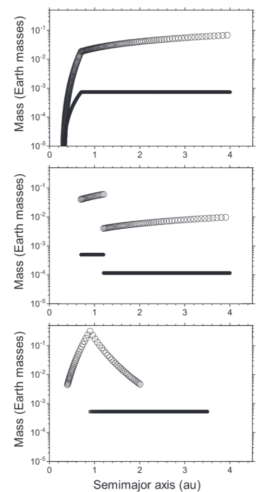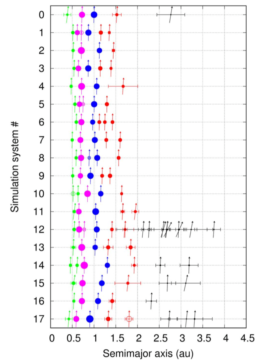Editor’s note: Astrobites is a graduate-student-run organization that digests astrophysical literature for undergraduate students. As part of the partnership between the AAS and astrobites, we occasionally repost astrobites content here at AAS Nova. We hope you enjoy this post from astrobites; the original can be viewed at astrobites.org.
Title: Constraining the Formation of the Four Terrestrial Planets in the Solar System
Authors: Patryk Sofia Lykawka and Takashi Ito
First Author’s Institution: School of Interdisciplinary Social and Human Sciences, Kindai University, Japan
Status: Published in ApJ
Our solar system is really unique. As far as we can tell after our first ~decade of exoplanet hunting and planet formation observations and theory, it’s quite the special snowflake. In order to answer one of the biggest questions in astronomy — “How did the Earth form?” — we first need to ask how our solar system formed. Our moon, Jupiter and Saturn, the asteroid belt, and our Sun’s solar activity all provide hints as to how one can possibly form this incredibly habitable planet on which we live. Inspired by this, today’s bite answers the question: How did the terrestrial planets form? The authors argue that in order to fully understand the formation of one planet, we really should be thinking of its formation as one member of a system.

Figure 1: The embryo (large circle) and planetesimal (small circle) mass and radial distribution derived to represent three different planet formation models: A normal distribution (top), Empty Asteroid Belt Model (middle), and pebble accretion (bottom). [Adapted from Lykawka & Ito 2019]
Simulating the Formation of Our Terrestrial Planets
The authors explore terrestrial planet formation through the medium of N-body simulations. They start with a number of embryos and planetesimals in a simulated solar environment. The embryos and planetesimals represent the large and small rocky bodies that are left over after gas dissipation of a protoplanetary disk, which is a remnant of stellar formation. We believe that our rocky/terrestrial planets are born out of collisions of these objects. The authors allow their simulated rocks to collide and interact with each other for a series of timesteps that equate to 400 million years. By that time, all of the planets will have formed and a stable system should be established. The authors create different initial distributions of the embryos and planetesimals that are inspired by different planet formation models, for example the Grand Tack model, Empty Asteroid Belt, and pebble accretion. They explore the mass ratios of embryos to planetesimals — i.e. which type of pre-solar body will carry the most mass. Is it mostly in the smaller pebble sized objects, or in the boulder sized objects?
The authors also have different configurations of the gas giant planets, which we believe should have mostly formed by the time terrestrial planets started to form. Their location and eccentricities would affect the movements of bodies within 2 AU. The authors run 540 different combinations of these initial contentions and let the rocks go wild. In addition to the final mass and location of the planets that form, they also keep track of the water mass fraction, which is the fraction of mass that water makes up on each planet. Water is transported to these planets via collisions. We know generally the water mass fraction of Mars and Venus, we know the value pretty darn well for Earth, and we really have no idea for Mercury. Finally, the authors also keep track of the giant impacts that each planet experiences. We believe our Moon came from a giant impact that happened early in the Earth’s formation. So for a simulated solar system to be an analog of our system, the planets should have similar water mass fractions and the correct number and timing of giant impacts.
Do You Have What It Takes to Be a Planet in the Solar System?
Out of these 540 different solar systems, it’s time to find the systems that are most like our own solar system. There are a few criteria to narrow down the options. The authors define the region within 2 AU of the star (where 1 AU is the distance of the Earth to the Sun, today) as the planetary region, and outside of that is the asteroid belt. Are there at least three planets in the planetary region? Yes? Good. Moving on. Are there at least two that are of Venus/Earth mass? Yeah? Fantastic. Next, identify which planet-analog is Venus and which is Earth. We can now define the Mercury and Mars regions inside the orbit of Venus and outside the orbit of Earth, respectively. Are there planets in these regions that correspond to Mercury’s and Mars’s masses? Maybe there are multiple! If so, we determine which is going to be the planet analog by using its radial location from the Sun. The authors used the above checklist to begin to determine which planet systems were most like ours. In the end, they found only seventeen systems that were similar to our terrestrial planet system.

Figure 2: The 17 terrestrial systems that were deemed solar-system analogs. The simulation system 0 is our solar system. Green dots are Mercury, pink is Venus, blue is Earth, red is Mars, and black is the dwarf planet Ceres. The size of each dot corresponds to a mass, and the arrow represents inclination. [Lykawka & Ito 2019]
The Ingredients to Make a Solar System
After synthesizing their results, the authors came down to five crucial criteria that are necessary to form the terrestrial planets:
- Disks need to start out with a concentration of total disk mass between ~0.7–1.2 AU — it helps form Venus and Earth.
- Disks need an inner region ~0.3–0.4 AU in order to form my favorite planet: Mercury.
- Beyond 1.2 AU up to the asteroid belt (~2 AU), there needs to be significantly less mass. This aids in the production of dwarf planets in the asteroid belt and helps achieve the correct mass ratio between Venus and Earth.
- The embryos (large boulder-y rocks) need to carry most of the mass of the disk, as opposed to planetesimals.
- Jupiter and Saturn need to be on eccentric orbits. This keeps the Mars-analog planet from getting too massive and chucks out any planets that meander over to the asteroid belt.
This paper aids our understanding of terrestrial planet formation and tests how well current planet formation theories can recreate Mercury, Venus, Earth, and Mars analogs. Some aspects, like the excess water we have on Earth, the orbital spacing, and inclination of the planets are still a mystery, but the authors do take us one step closer to understanding the uniqueness of our solar system.
About the author, Jenny Calahan:
Hi! I am a second year graduate student at the University of Michigan. I study protoplanetary disk environments and astrochemistry, which set the stage for planet formation. Outside of astronomy, I love to sing (I’m a soprano I), I enjoy crafting, and I love to travel and explore new places. Check out my website: https://sites.google.com/umich.edu/jcalahan
